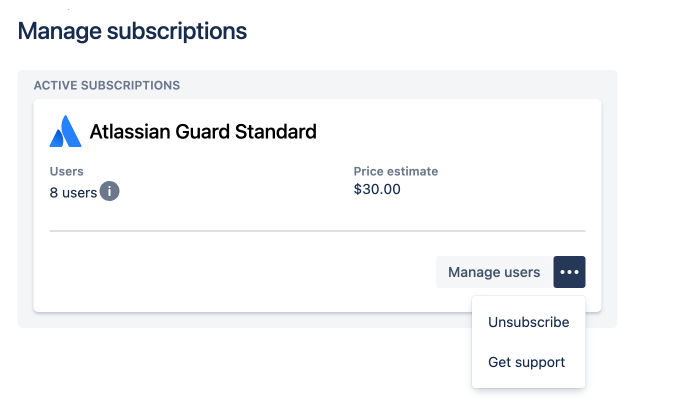Unsubscribe from Atlassian Guard Standard
Atlassian Guard Standard (formerly known as Atlassian Access) provides centralized control of user security across all your Atlassian cloud apps. Understand Atlassian Guard
How to unsubscribe
When you unsubscribe from Atlassian Guard Standard:
Your Atlassian Guard Premium add-on subscription will also be canceled.
There is no effect on your Atlassian cloud apps subscriptions, which continue as previously. Read more about canceling your subscriptions
There are likely to be changes to how your users log in to the Atlassian cloud apps they use. See below for details.
If you resubscribe in the future, the price may be different from what you are paying today.
We’re rolling out an improved billing experience to make it easier to manage your cloud subscriptions. This means your subscriptions could be managed on either the original or the improved experience. Read more about the key differences
Improved billing experience
To cancel Atlassian Guard:
Go to Atlassian Administration. Select your organization if you have more than one.
Select Billing.
Find Atlassian Guard from the list and select Manage.
Select more actions > Cancel subscription, then review and confirm your cancelation.
Once your subscription is canceled, it will appear in the Inactive tab of the Subscriptions page.
When you cancel your subscription, it’s deactivated for 60 days after the end your current subscription period. Read about what happens when you cancel a subscription
Original billing experience
As an organization admin, you can unsubscribe from an Atlassian Guard Standard trial or paid subscription as follows:
Go to Atlassian Administration. Select your organization if you have more than one.
Select Billing > Atlassian Guard Standard > Manage Subscriptions.
From the Atlassian Guard Standard card, choose Unsubscribe from the drop down.

3. From the screen that appears, confirm you want to unsubscribe by entering UNSUBSCRIBE in the text box.
Changes that your users will notice
Your users will immediately see the following changes if you unsubscribe.
SAML single sign-on
If you have SAML single sign-on configured when you unsubscribe from Atlassian Guard Standard, your users will no longer be able to use SAML single sign-on when they log in:
Users who had an Atlassian account prior to when they were required to log in with SAML single sign-on will simply revert to using their Atlassian account password to log in.
Users who have only ever used SAML single sign-on to log in will need to set an Atlassian account password. They are not told that they need to set a password when trying to log in. However, after a failed login attempt, an alert will prompt them to consider resetting their password if experiencing login issues.
Note that users do not get an email to tell them that your organization has stopped using SAML single sign-on. Read more about SAML single sign-on
Enforced two-step verification
If you have two-step verification configured when you unsubscribe from Atlassian Guard Standard:
Two-step verification remains enabled for your managed users, but those users will be able to disable two-step verification (should they wish to) by going to their Atlassian account settings at id.atlassian.com.
Any new accounts added to your organization will not be required to enable two-step verification.
Read more about enforced two-step verification
Authentication policies
When you unsubscribe from Atlassian Guard Standard, we’ll make changes to your authentication policy settings and members. If you have multiple policies you will lose all of them except for one policy.
If you have a nonbillable policy, you’ll keep it. If you don’t have a nonbillable policy, you’ll keep your default policy.
When you have a nonbillable policy and unsubscribe from Atlassian Guard Standard, here’s what happens:
We delete all other policies and their settings
We keep your password and idle session settings and you can edit them
We move all members from the policies we delete to your nonbillable policy
You keep your nonbillable policy and it becomes your default policy.
When you have a default policy and unsubscribe from Atlassian Guard Standard, here’s what happens:
We delete all other policies and their settings
We keep your password and idle session settings and you can edit them
We move all members to your default policy
We remove single sign-on and 2-step verification settings
You keep your default policy.
Read more about authentication policies
Data security policies
Some data security policy rules and coverage types require Atlassian Guard Standard or Atlassian Guard Premium.
When you unsubscribe from Atlassian Guard Standard:
Data security policies that require Atlassian Guard will continue to be enforced, but will not be editable. This is to reduce the risk of data egress if you accidentally let your subscription lapse. You can deactivate or delete any policies you no longer need.
For data security policies that block selected app access to data, you'll have the option to switch to block all apps, which does not require an additional subscription. Once you change the policy to block all apps, the policy coverage will become editable again.
If you restart your subscription any existing data security policies will become editable again.
Atlassian Guard Premium features
If you also have an Atlassian Guard Premium subscription, you will lose access to premium features including:
Data classification
Guard Detect alerts
Certain Atlassian Administration audit logs features
Read more on how to unsubscribe from Atlassian Guard Premium
Was this helpful?